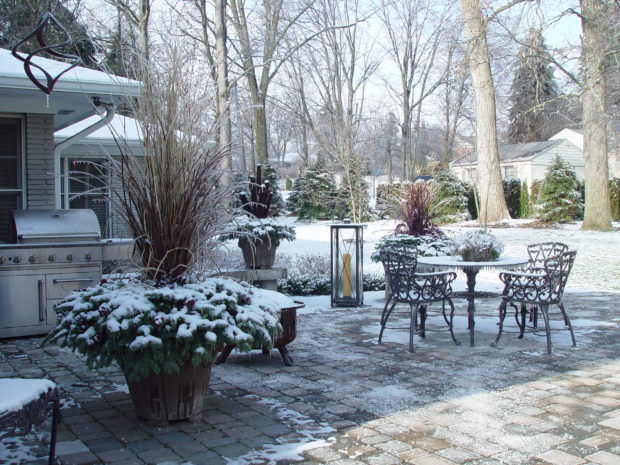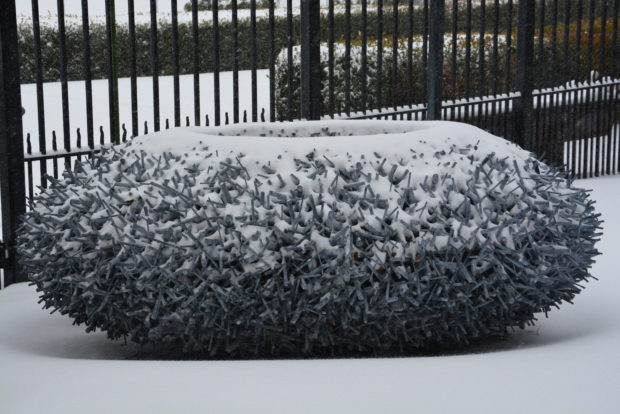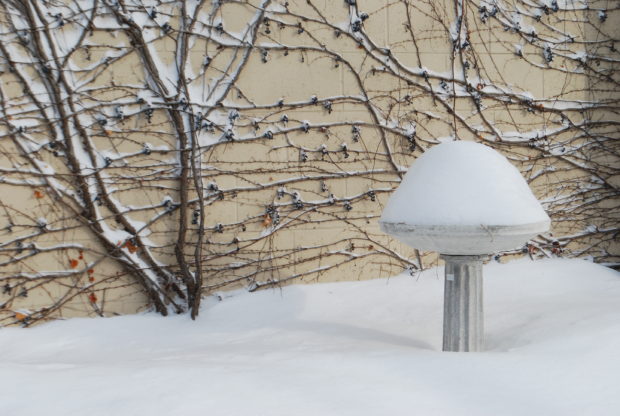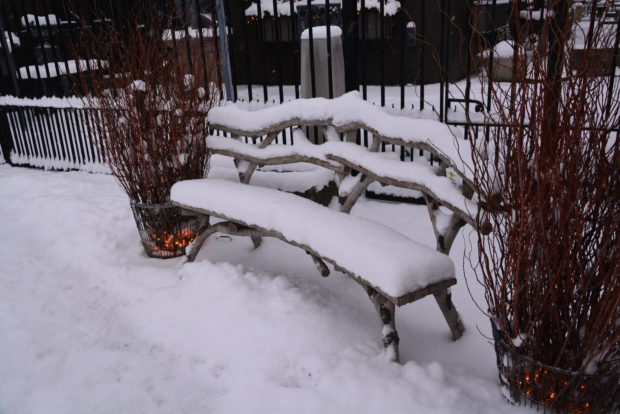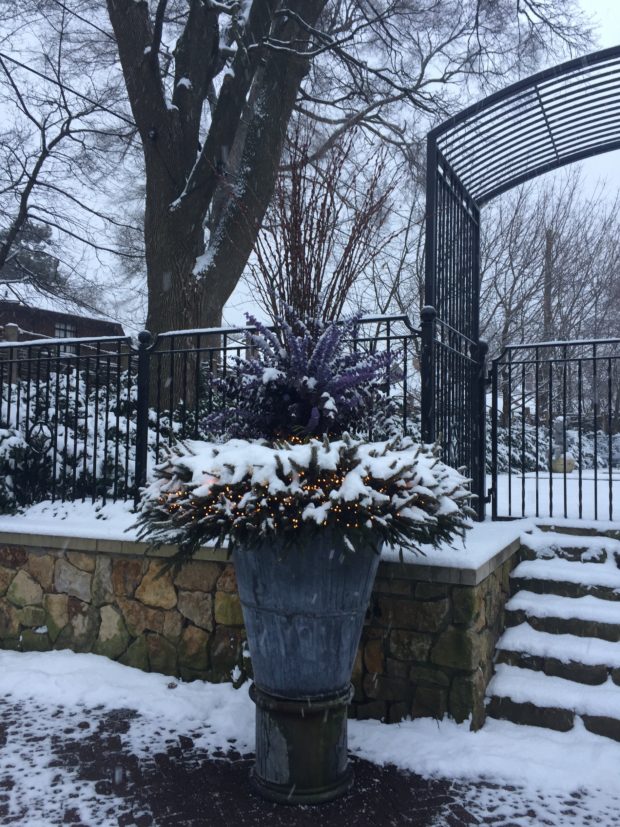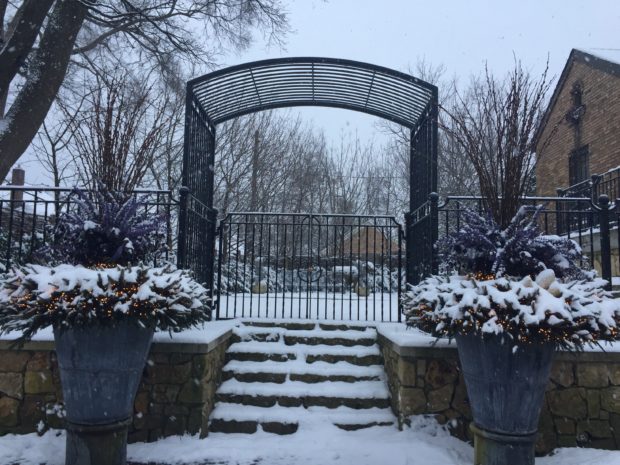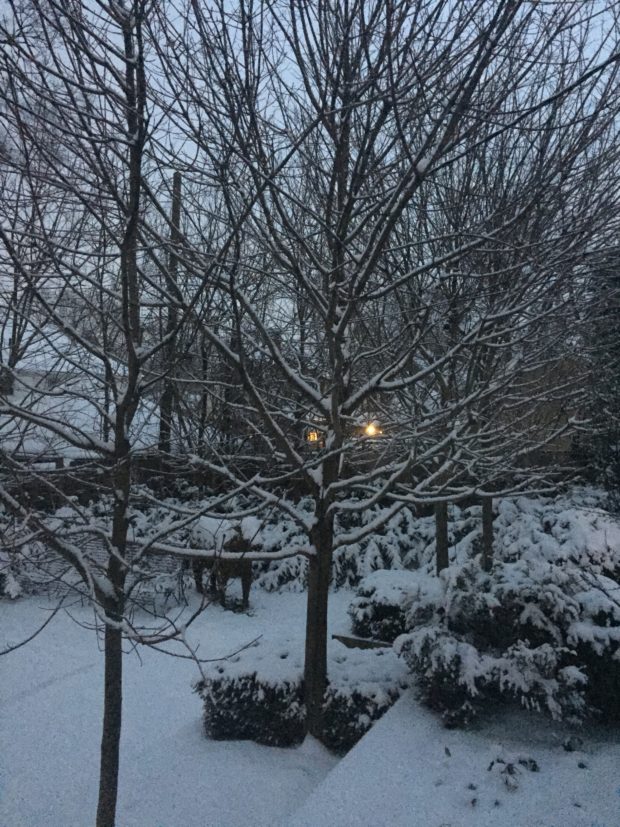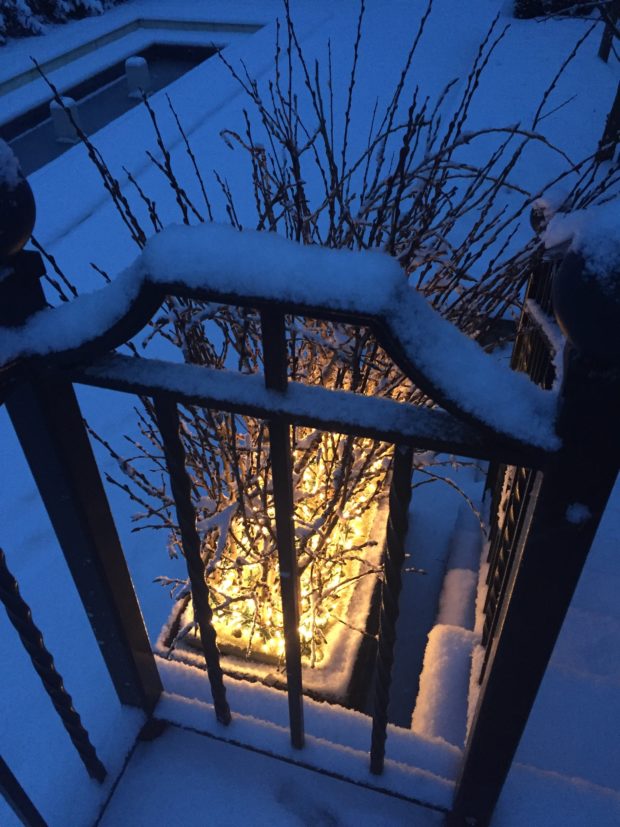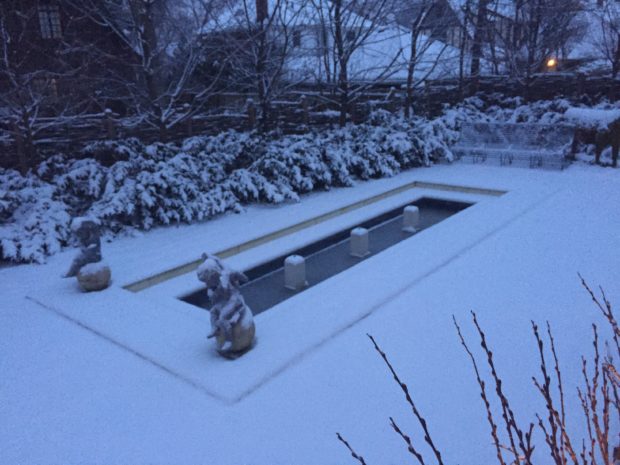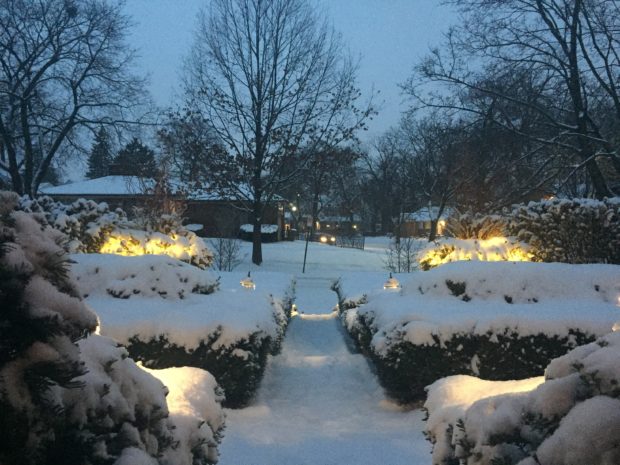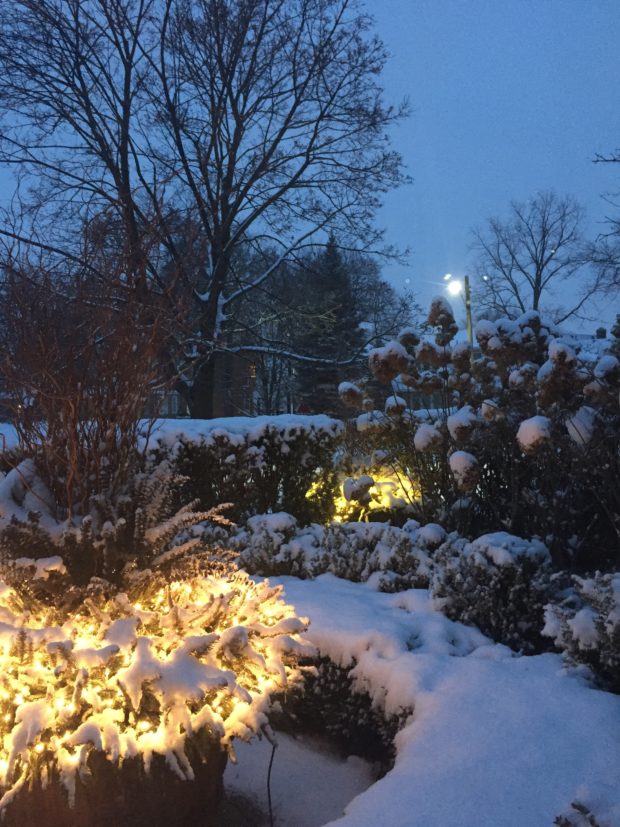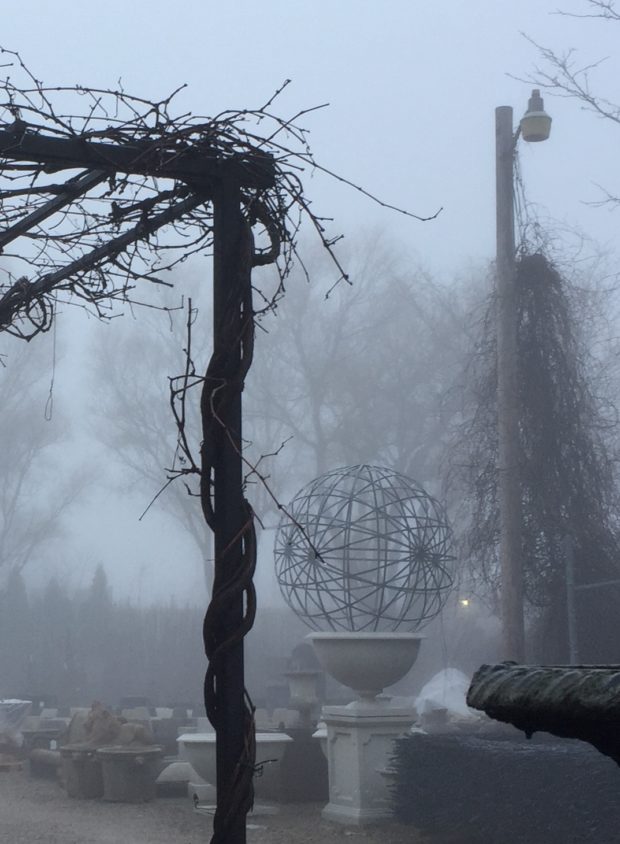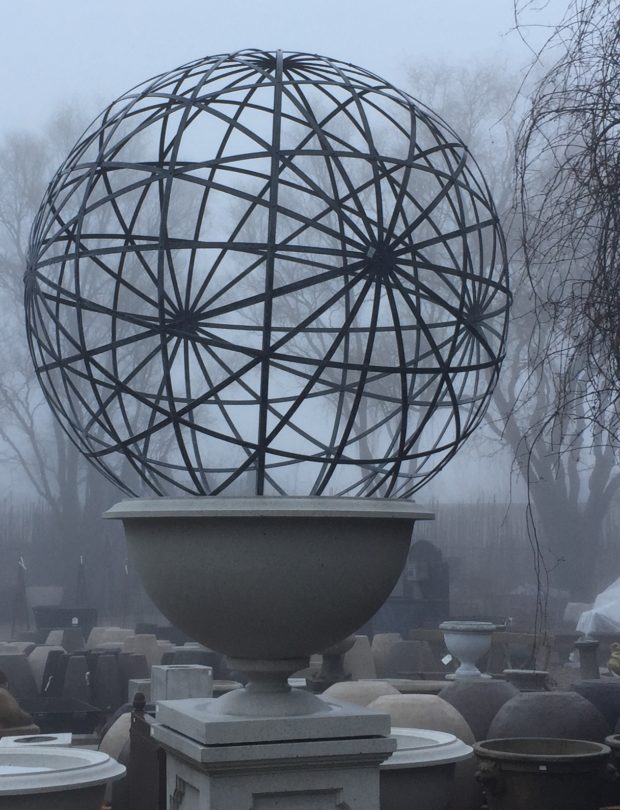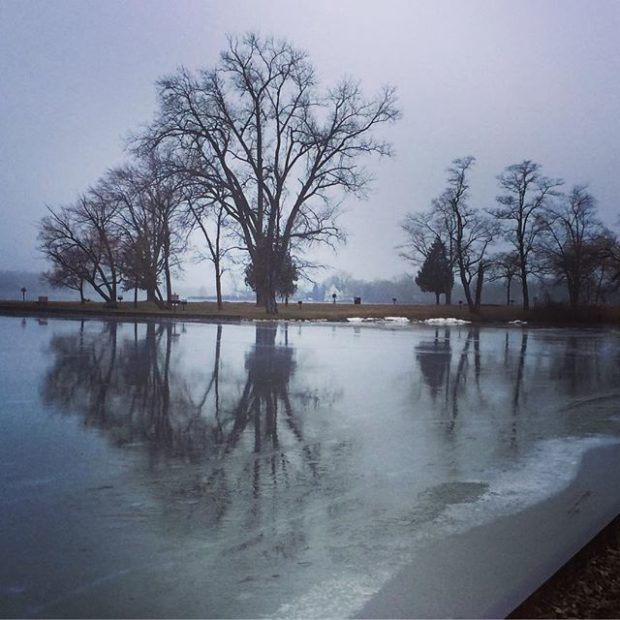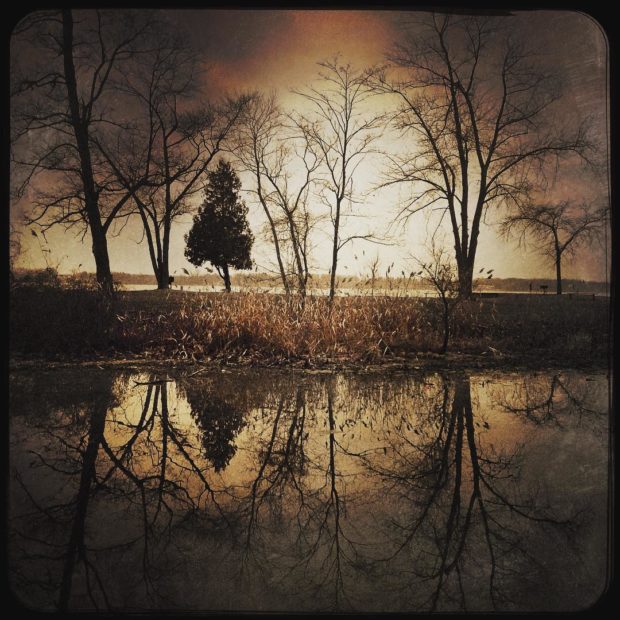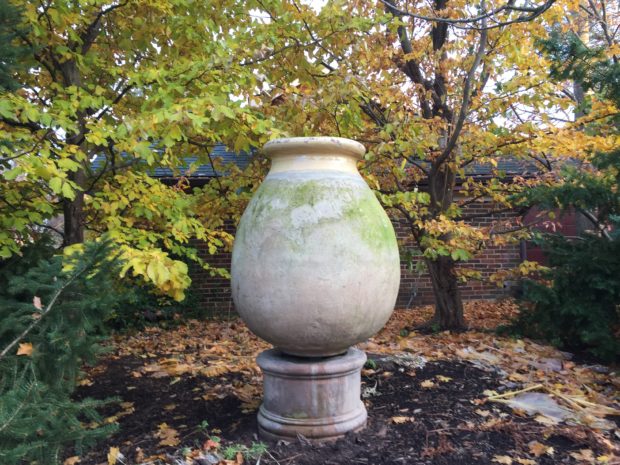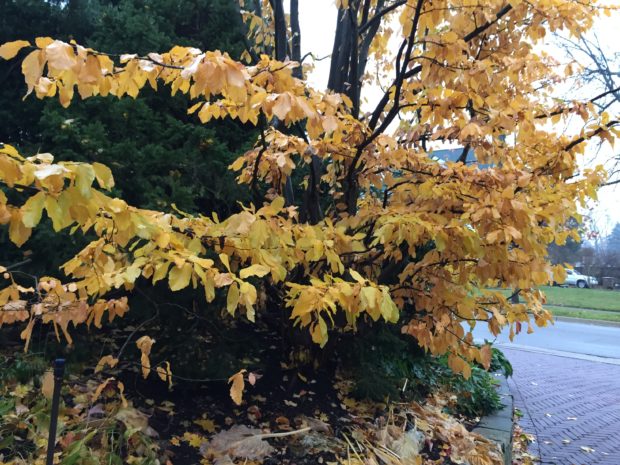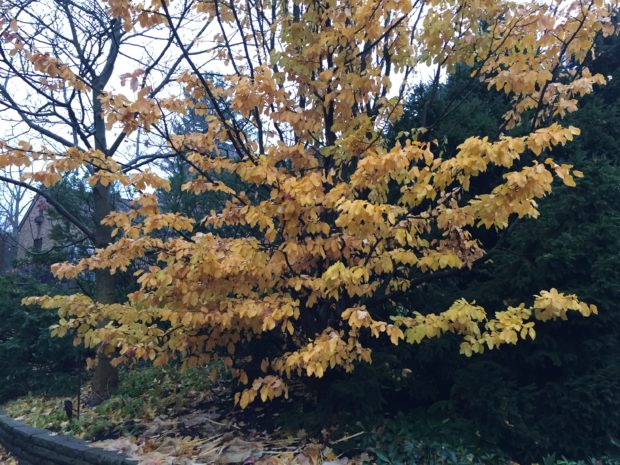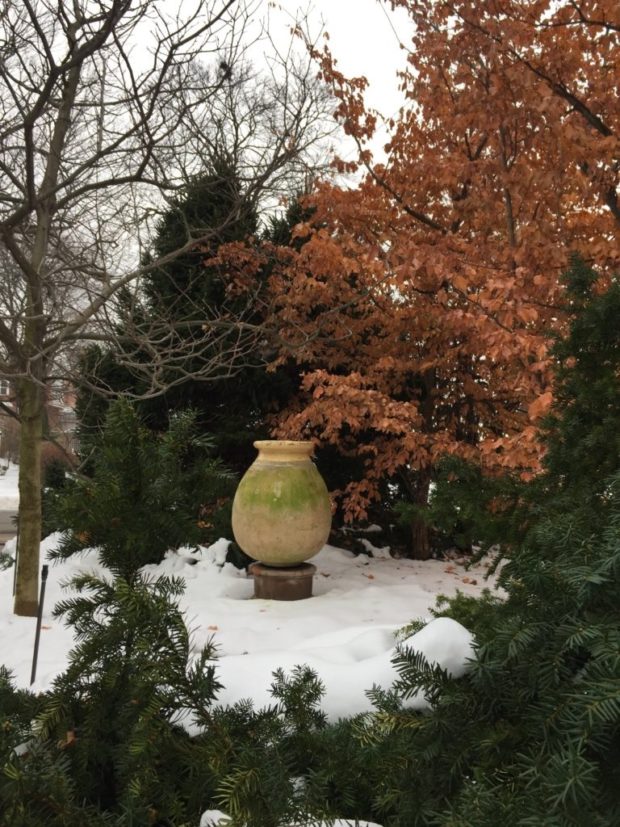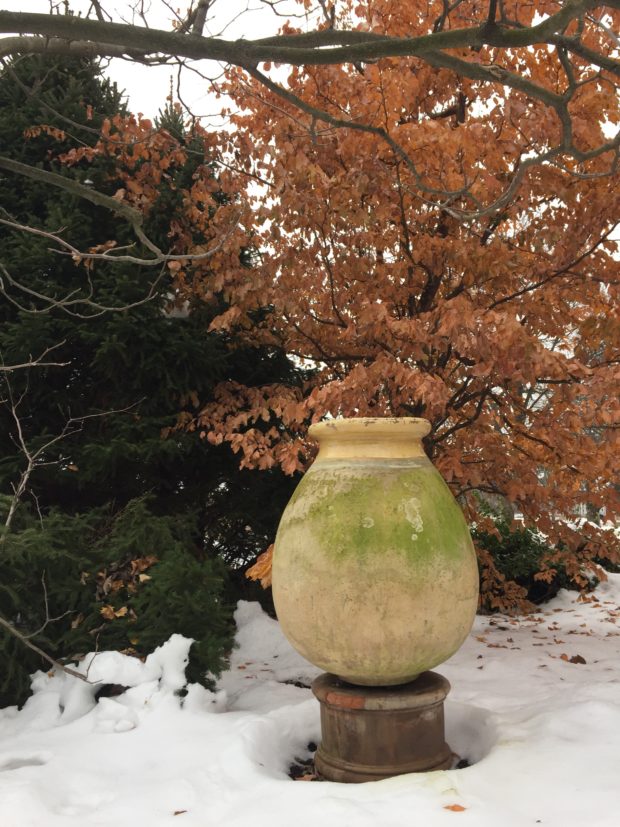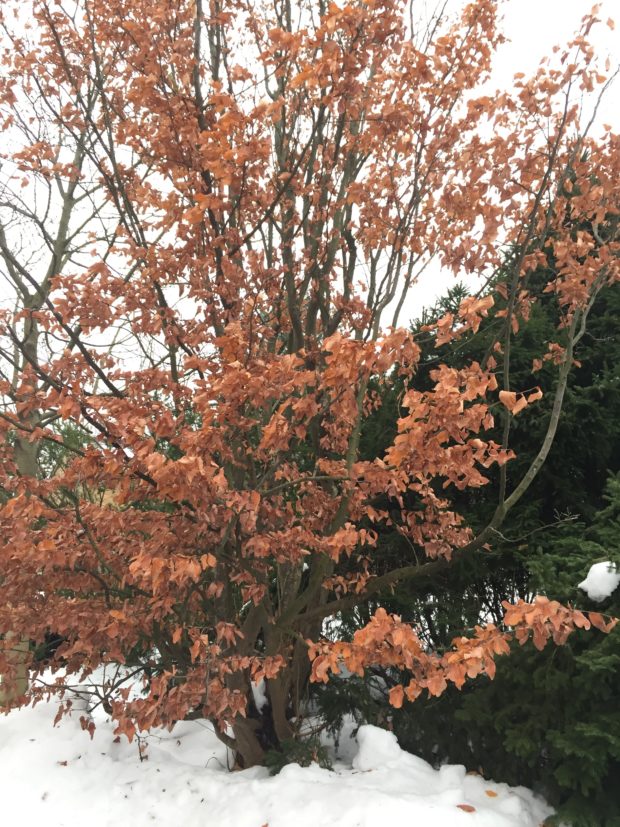 Though a landscape that is striking in all of the seasons largely depends on the confluence of a great design, interesting hard scape and thoughtful choices of plant material, I would venture to say that ornament in the landscape plays an especially vital role in our winter. The plants are welcome to be the star of the show every season of the year, as they should be. The walkways, driveways, and terraces facilitate flow, and provide places for people to be a part of it all. The 4th season in northern landscapes have a regional set of challenges. All the deciduous plants sulk in the advancing cold, shed their leaves, and go dormant for the winter. The trees stand firm and skeletal in the winter; the trunks and branches are indeed very sculptural. The branchy remains of shrubs and perennials rattle in the wind. This seasonal plant sculpture is not by choice. A gardener might say there is no meat in this scene. The evergreens are indeed green, but they can have a stiff and stoic look in their glazed over and embattled winter state, quite unlike their lively spring to fall life. The walks, terraces and driveways meant to welcome people into the landscape disappear under scarcely an inch of snow. The ground plane is at best obscured, and at worst, buried in our winters. Winter in Michigan is not so easy a season for gardeners. Long suffering is a phrase that applies. But there are ways to help mitigate that grief. Garden ornament? By this I mean any object with a distinct profile that has a year round home in a landscape. Any object placed in the landscape that is marked by shape, mass, personality, memory, and persistence endows the winter landscape. I am talking about those garden ornaments that have both a physical and emotional presence that cannot be snowed in, or grayed out. They are all the better for a coating of ice, or a hat of snow. Pots, fencing, arbors, statuary, furniture, sculptures, fountains, architectural fragments, fire pits, bird baths, armillary spheres – all of these garden ornaments have a surprisingly lively and welcome life in the winter.
Though a landscape that is striking in all of the seasons largely depends on the confluence of a great design, interesting hard scape and thoughtful choices of plant material, I would venture to say that ornament in the landscape plays an especially vital role in our winter. The plants are welcome to be the star of the show every season of the year, as they should be. The walkways, driveways, and terraces facilitate flow, and provide places for people to be a part of it all. The 4th season in northern landscapes have a regional set of challenges. All the deciduous plants sulk in the advancing cold, shed their leaves, and go dormant for the winter. The trees stand firm and skeletal in the winter; the trunks and branches are indeed very sculptural. The branchy remains of shrubs and perennials rattle in the wind. This seasonal plant sculpture is not by choice. A gardener might say there is no meat in this scene. The evergreens are indeed green, but they can have a stiff and stoic look in their glazed over and embattled winter state, quite unlike their lively spring to fall life. The walks, terraces and driveways meant to welcome people into the landscape disappear under scarcely an inch of snow. The ground plane is at best obscured, and at worst, buried in our winters. Winter in Michigan is not so easy a season for gardeners. Long suffering is a phrase that applies. But there are ways to help mitigate that grief. Garden ornament? By this I mean any object with a distinct profile that has a year round home in a landscape. Any object placed in the landscape that is marked by shape, mass, personality, memory, and persistence endows the winter landscape. I am talking about those garden ornaments that have both a physical and emotional presence that cannot be snowed in, or grayed out. They are all the better for a coating of ice, or a hat of snow. Pots, fencing, arbors, statuary, furniture, sculptures, fountains, architectural fragments, fire pits, bird baths, armillary spheres – all of these garden ornaments have a surprisingly lively and welcome life in the winter.
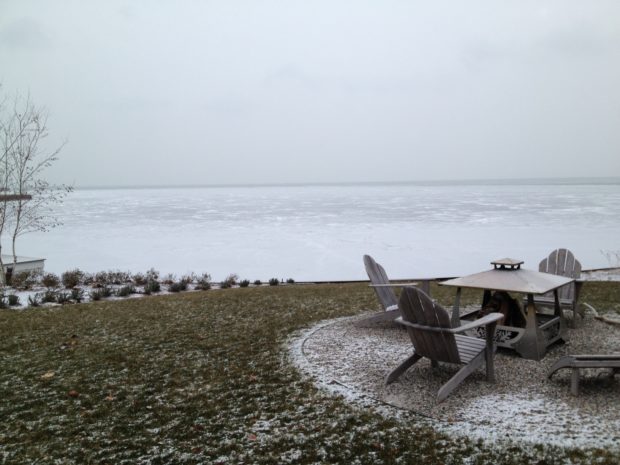 Those of you who put your garden furniture in the basement for the winter might consider this. The heat and relentless sun common in the summer season is much harder on garden furniture than anything the winter season might dish out. I leave my garden furniture out all winter. Though it is unlikely I will sit out in the winter, garden furniture is ornamental in the winter. That furniture can organize a view, even though the terrace upon which it sits is snowed under. The memory of the summer season warms the winter landscape. It may be that how I visually react to my summer furniture out in the winter landscape is stronger than my summer view. In the summer, my terrace furniture is about its use. In the winter, that furniture is a sculpture that speaks to the future.
Those of you who put your garden furniture in the basement for the winter might consider this. The heat and relentless sun common in the summer season is much harder on garden furniture than anything the winter season might dish out. I leave my garden furniture out all winter. Though it is unlikely I will sit out in the winter, garden furniture is ornamental in the winter. That furniture can organize a view, even though the terrace upon which it sits is snowed under. The memory of the summer season warms the winter landscape. It may be that how I visually react to my summer furniture out in the winter landscape is stronger than my summer view. In the summer, my terrace furniture is about its use. In the winter, that furniture is a sculpture that speaks to the future.
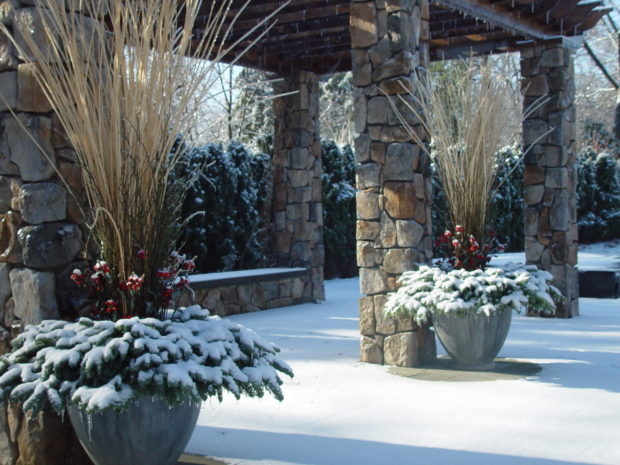 This pergola with a wood roof and stone pillars was built to shrug off off anything the Michigan winter has to deliver. It is successful in that regard. The winter pots dusted with snow are landscape ornaments set at eye level that warm both that pergola, and this landscape. They counter the winter with the evidence of the gardening hand. An ornament selected for a garden or landscape is first and foremost a personal choice. Though I dressed these pots for winter for a client, it is her aura that enlivens this winter landscape.
This pergola with a wood roof and stone pillars was built to shrug off off anything the Michigan winter has to deliver. It is successful in that regard. The winter pots dusted with snow are landscape ornaments set at eye level that warm both that pergola, and this landscape. They counter the winter with the evidence of the gardening hand. An ornament selected for a garden or landscape is first and foremost a personal choice. Though I dressed these pots for winter for a client, it is her aura that enlivens this winter landscape.
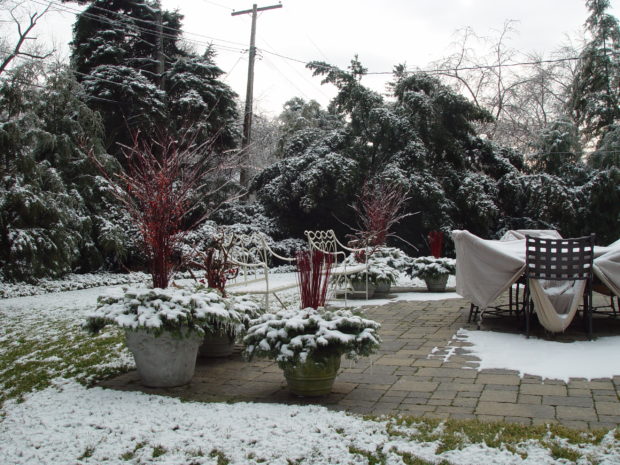 To follow are a group of pictures of what I call ornament in the winter landscape. They that tell a story far better than I ever could. I rarely have cause to visit a client’s landscape in the winter. But when I go, I am struck by how garden ornament can improve, organize and energize the look of a landscape gone dormant.
To follow are a group of pictures of what I call ornament in the winter landscape. They that tell a story far better than I ever could. I rarely have cause to visit a client’s landscape in the winter. But when I go, I am struck by how garden ornament can improve, organize and energize the look of a landscape gone dormant.
 A container, and an arrangement to go with for winter, can provide a focal point for the landscape that might be more welcome and more striking than that same container planted for summer. The winter season can be a good gardening season. It just asks for more. I would not want to be gardening in any other place than where I am gardening. Even in the winter.
A container, and an arrangement to go with for winter, can provide a focal point for the landscape that might be more welcome and more striking than that same container planted for summer. The winter season can be a good gardening season. It just asks for more. I would not want to be gardening in any other place than where I am gardening. Even in the winter.
 Window boxes mounted outside a sun room, and dressed for winter.
Window boxes mounted outside a sun room, and dressed for winter.
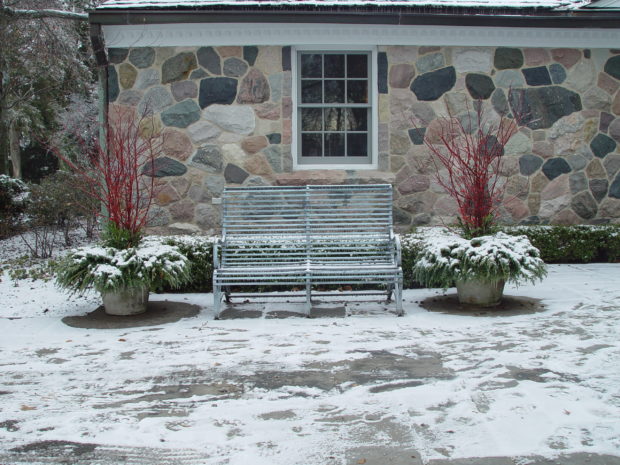 a bench and pots in the winter season
a bench and pots in the winter season
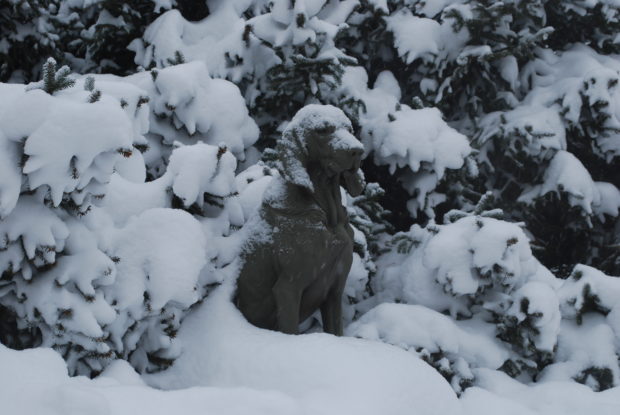 sculpture in the winter landscape
sculpture in the winter landscape
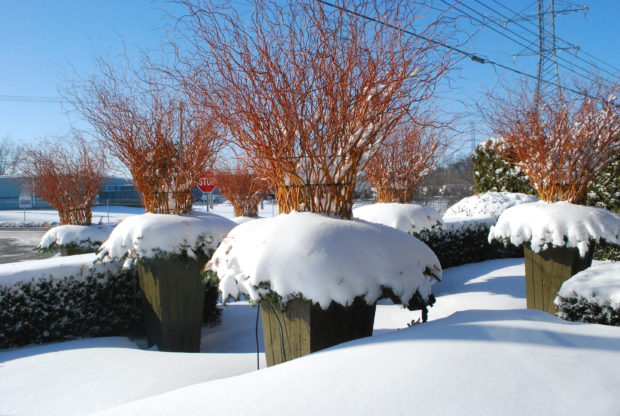 winter containers loaded with snow
winter containers loaded with snow
 pots dressed for winter with a dusting of snow
pots dressed for winter with a dusting of snow
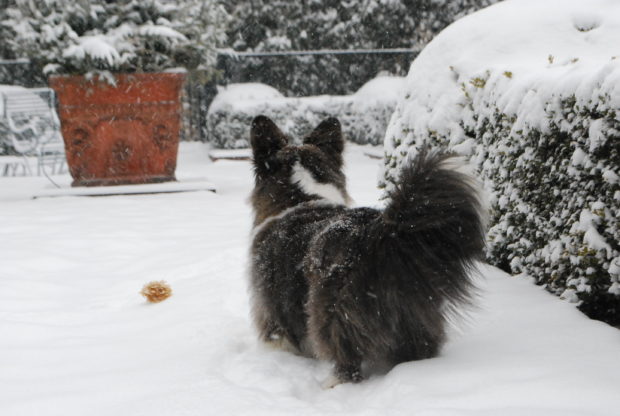 Ornament in the winter landscape can be supremely satisfying. I was right behind Milo this winter day. We both liked what was there to see.
Ornament in the winter landscape can be supremely satisfying. I was right behind Milo this winter day. We both liked what was there to see.
